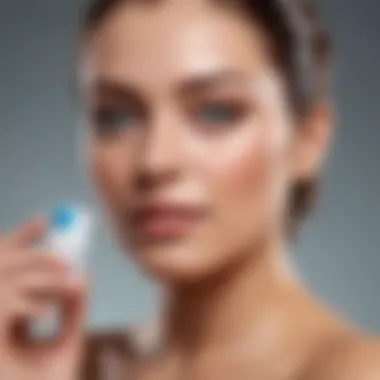Post-Shaving Care: Using Deodorant Safely


Intro
Maintaining personal hygiene after shaving the pubic area is a crucial aspect of self-care. The skin in this area is often sensitive and requires gentle treatment to avoid irritation. Using deodorant post-shaving may seem practical, but it is essential to understand its implications on skin health. This article clarifies the risks and benefits associated with deodorant use in this sensitive region, helping readers make well-informed choices about their grooming routines.
Insider Beauty Tips
When it comes to post-shaving care in the pubic region, some insider tips can enhance your routine significantly.
Choosing the Right Deodorant
It's wise to select deodorants formulated for sensitive skin. Look for products labeled as hypoallergenic or devoid of harsh chemicals. Natural ingredients like aloe vera and chamomile can be particularly soothing. Avoid fragrances and alcohol, as these can lead to irritation.
Application Timing
Timing the application of deodorant is essential. Apply it at least 30 minutes after shaving to ensure that the skin's micro-cuts have begun to heal. This practice minimizes the risk of stinging or inflammation.
Technique
Using gentle strokes during application can help reduce further irritation. It is best to dab rather than rub the deodorant onto the skin. This ensures an even application without exacerbating any existing sensitivity.
"Deodorant use in sensitive areas should be approached with caution. Choose wisely."
Pre- and Post-Shaving Care
A comprehensive routine includes
- Pre-Shaving Preparation: Start with a warm shower. This helps to soften the hair and opens up the pores, making shaving easier. Use a sharp razor and a high-quality shaving cream designed for sensitive skin.
- Post-Shaving Care: After shaving, rinse with cool water to calm the skin. Pat dry with a clean towel to avoid irritation. Consider using a soothing balm or lotion devoid of fragrances to promote healing.
These steps establish a foundation for not just hygiene but also skin health.
Potential Skin Reactions
Awareness of possible skin reactions is vital. Some individuals may experience:
- Redness
- Swelling
- Burning Sensation
Should these occur, it is critical to discontinue use of the product immediately. Opting for an anti-inflammatory cream can help alleviate symptoms while avoiding products with potential irritants is advisable.
Culmination
Navigating the world of deodorants post-shaving in the pubic area entails a well-rounded approach. Selecting the right products and techniques can preserve skin health while promoting hygiene. Understanding your skin's unique needs can lead to a comfortable, confident grooming experience.
Understanding the Pubic Area
The significance of comprehending the pubic area cannot be overstated, especially in the context of post-shaving care. This region, often subjected to various grooming practices, is more than just skin; it is sensitive and requires careful attention. The pubic area is home to unique anatomical structures and skin types that respond differently to shaving and subsequent treatment. Understanding these nuances is crucial for effective and safe grooming.
The pubic area houses a variety of hair follicles, sweat glands, and nerves. This anatomical makeup contributes to its distinct sensitivity compared to other body regions. Recognizing the sensitivity can help determine the appropriate products and practices to use after shaving. Furthermore, consideration of this area’s unique skin characteristics informs the selection of deodorants that will not exacerbate irritation or discomfort.
Benefits of Understanding the Pubic Area:
- Improved skin health: Knowledge about the anatomy leads to better choices regarding post-shaving products, promoting healing and comfort.
- Enhanced grooming safety: Understanding sensitivity can reduce the risk of injuries or reactions during grooming.
- Tailored personal care: With proper knowledge, individuals can choose specific deodorants and skincare routines that address their needs.
Awareness of grooming practices is crucial in maintaining the integrity of the skin in the pubic area. This section aims to provide a foundation for why understanding the pubic area is essential, leading to informed decisions about products and methods that can ensure both hygiene and skin health.
Anatomy and Sensitivity
The anatomy of the pubic area is characterized by various structures, each playing a role in its functionality and sensitivity. Here, hair follicles are densely packed, providing a barrier against environmental elements, while sweat and sebaceous glands are present to maintain skin hydration and protection. This delicate balance can shift post-shaving.


After shaving, the skin in this region may enter a more vulnerable state. The removal of hair, coupled with the potential for blade irritation, can lead to discomfort. Skin redness, itching, and even minor cuts are common concerns. Hence, awareness of this sensitivity is essential to select appropriate aftercare products.
Common Grooming Practices
Grooming practices in the pubic area vary widely among individuals. Some people opt for full shaving, while others may prefer trimming or waxing. Regardless of the method chosen, certain common practices can impact skin health.
- Shaving: This is a prevalent technique that can lead to ingrown hairs, redness, or bumps if not done correctly. Using the right tools is vital here.
- Waxing: While it provides longer-lasting results, waxing can lead to skin irritations. Aftercare is crucial following this method.
- Trimming: This is a gentler approach that minimizes the risk of irritation but may not offer the cleanliness that complete shaving provides.
These practices form the foundation for understanding what post-shaving care may be necessary. Based on the grooming method employed, an individual can better anticipate the need for deodorants and other skincare solutions.
The Shaving Process
Shaving the pubic area requires careful attention, as the skin in this region is often more sensitive compared to other parts of the body. Understanding the shaving process is crucial in ensuring not only a clean and comfortable result but also minimizing the risk of irritation or injury. Proper techniques and tools can significantly influence the final outcome, making this step essential in post-shaving care.
Choosing the Right Tools
Selecting suitable tools for shaving is the cornerstone of an effective grooming routine. It's important to use a razor designed for sensitive skin. Razors with multiple blades may provide a closer shave, but they can also lead to increased irritation. Therefore, a single blade or a safety razor may be preferable for this sensitive area.
Additionally, consider using a blade with lubricating strips. These strips can reduce friction, further protecting the skin during the shaving process. In terms of shaving cream or gel, opt for products that are fragrance-free and specifically marketed for sensitive skin.
Here are some key points on choosing shaving tools:
- Razor Type: A single-blade razor or safety razor is often best.
- Lubricating Strips: Found on some razors, they can help minimize irritation.
- Shaving Creams: Use products without strong fragrances or irritating ingredients.
Shaving Techniques for Sensitive Areas
When it comes to shaving techniques, gentleness and precision are key. Always start with a clean area to avoid infection. The skin should be hydrated prior to shaving, which can be achieved with warm water or a warm compress. This will help soften the hair and open up pores, reducing the likelihood of nicks and cuts.
Shave in the direction of hair growth to reduce irritation. Shaving against the grain might provide a closer shave but often leads to more irritation, especially in delicate areas. Use short strokes and do not rush. Take your time to ensure a smooth glide of the razor across the skin.
To avoid irritation, consider the following techniques:
- Hydrate: Use warm water to prepare the area.
- Shave Direction: Always shave in the direction of hair growth.
- Short Strokes: Do not make large strokes; keep them short and deliberate.
Pre-Shave Preparation
Pre-shave preparation is crucial in ensuring a better shaving experience. Take a moment to clean the area thoroughly with mild soap and warm water. This not only removes any impurities but also softens the hair, making it easier to cut. Applying a pre-shave oil can also help in providing an extra layer of protection, which can further reduce friction and improve comfort.
It is advisable to exfoliate the area a day or two before shaving. This helps in removing dead skin cells and can prevent ingrown hairs. Remember to rinse thoroughly to ensure no products are left on the skin that could cause irritation during shaving.
Key steps for effective pre-shave preparation include:
- Clean: Wash the area with mild soap and warm water.
- Exfoliate: Consider exfoliating a day or two prior to shave.
- Use Pre-shave Oil: Applying a thin layer can improve comfort and reduce irritation.
The Role of Deodorant
Deodorant plays a significant role in post-shaving care, especially for sensitive areas like the pubic region. After shaving, the skin can become prone to irritation, which can intensify body odor. Deodorant provides a barrier and helps in reducing unpleasant smells while also promoting general hygiene. It acts not only as a fragrance mask but helps to control bacterial growth, thus, contributing to a fresher feeling throughout the day.
The specific considerations when using deodorant in this sensitive area include choosing the right products that will not exacerbate irritation or cause allergic reactions. Additionally, understanding how and when to apply deodorant can help in maximizing its benefits while ensuring skin health.
Purpose of Deodorant in Personal Care
The primary purpose of deodorant in personal care is to manage body odor. For many, this is an essential part of their daily hygiene routine. In the pubic area, where moisture and warmth are prevalent, odor control takes on added significance.
Some of the key benefits of using deodorant in this area are:
- Odor Control: Reduces unpleasant smells that can arise from sweat and bacteria.
- Comfort: Provides a sense of freshness, which can enhance overall comfort throughout the day.
- Skin Protection: Acts as a protective layer that helps prevent chafing during physical activity.


Types of Deodorants Available
When choosing deodorants for sensitive areas, it is important to consider different types available in the market. They vary in formulation and suitability for the pubic region:
- Roll-On Deodorants: Commonly used, they offer a gentle application method that can be easy to control.
- Spray Deodorants: These can provide a quick and refreshing application but may contain alcohol, which could irritate sensitive skin.
- Stick Deodorants: Often more hydrating and soothing, these are typically creamy and easy to apply.
- Natural Deodorants: Made from plant-based ingredients, these can be an excellent alternative for those who prefer a more organic choice.
- Gels: These are light and absorb quickly, potentially offering a cooling sensation.
When selecting, consider sensitivity and any known allergies. Testing on a small area before full application can help in ensuring compatibility with the skin.
Applying Deodorant After Shaving
Using deodorant after shaving the pubic area is more than a matter of preference; it is a step that can significantly affect skin health and comfort. The main reasons to apply deodorant post-shaving include odor control, moisture management, and skin protection. After shaving, the skin can be particularly sensitive and more susceptible to irritation and bacteria. Deodorant can act as a barrier against odors and help keep the area clean and fresh. However, choosing the right product is essential, as not all deodorants are suitable for sensitive skin.
Timing of Application
The timing of applying deodorant is crucial. Ideally, it should be applied shortly after shaving. This time frame allows the product to effectively combat any potential odors while the skin is still clean. However, consider allowing the skin to rest for a few minutes after shaving before application. This pause can minimize irritation since shaving can leave microscopic cuts. When the skin is dry, even if slightly, it is more receptive to the deodorant, allowing for better absorption without noticeble discomfort.
Methods for Application
Applying deodorant in the pubic area requires a careful approach. Here are some recommended methods:
- Roll-On: A roll-on applicator can provide a more controlled application. It minimizes contact and ensures an even spread without unnecessary irritation.
- Spray: If using a spray, maintain a distance of around 6 to 12 inches from the skin to avoid overwhelming the area. A light mist can be effective.
- Stick: Stick deodorants allow for a direct application and can provide more protection, but ensure the stick is applied evenly and not pushed too hard against the skin.
It is advisable to avoid excessive amounts of deodorant on the area; a small amount will often suffice to achieve the desired effect. Each person's skin chemistry varies, so it might take some trial and error to find the method and product that works best.
"Applying deodorant is not just about smell. It is essential for comfort and skin health, especially in sensitive areas."
Using deodorant after shaving can facilitate a smoother and more comfortable experience, but one must stay aware of the skin's needs to maintain its health and integrity.
Potential Skin Reactions
Understanding potential skin reactions is crucial in the context of post-shaving care in the pubic area. The pubic area is particularly sensitive and prone to adverse reactions due to its delicate skin and the nature of the grooming process. Knowing these reactions can help individuals make informed decisions about the products they use, thereby minimizing discomfort and enhancing skin health.
Irritation and Allergic Reactions
Irritation can occur due to several factors. Shaving itself can disrupt the skin's protective barrier, leading to redness, soreness, or a burning sensation. Adding deodorants that contain harsh chemicals often exacerbates these issues. Individuals with sensitive skin may find themselves more susceptible to irritation or allergic reactions following shaving. It is not uncommon for some products to trigger allergic responses, presenting symptoms such as rashes, swelling, or itching.
When choosing deodorants, it is essential to be cautious. Ingredients like fragrances, alcohol, and certain preservatives can be irritants. Instead, opting for unscented, hypoallergenic formulas can significantly reduce the risk of negative skin responses. Testing a small area of skin before widespread application also serves as a preventive measure.
Preventive Measures
Prevention is always better than treatment, especially for sensitive skin in the pubic region. Here are some effective preventive measures:
- Choose the right products: Select deodorants specifically formulated for sensitive skin. Look for ingredients that are soothing and nourishing, such as aloe vera or chamomile.
- Perform patch tests: Before applying a new deodorant, test it on a small area of skin to check for reactions. Waiting 24 hours can help detect any adverse reaction before the product is fully applied.
- Maintain hygiene: Keeping the area clean before and after shaving helps minimize the chances of irritation. Use mild cleansers and avoid harsh scrubs that can compromise the skin's barrier.
- Moisturize regularly: Hydration is essential for maintaining skin integrity. A good moisturizer should be applied after shaving and before deodorant application to help prevent dryness and irritation.
"Choosing the right post-shaving care products can safeguard sensitive skin against irritation and promote overall comfort."
Adopting these measures not only mitigates the chances of irritation but also promotes healthier skin conditions in the long term. Understanding your skin and taking proactive steps will lead to improved experiences with personal care routines.
Alternatives to Deodorant
When considering post-shaving care for the pubic area, it's essential to explore alternatives to conventional deodorants. While deodorants serve their purpose in maskng body odor, they may not always suit sensitive skin, particularly in delicate areas. In this section, we address why exploring alternatives can be beneficial, focusing on specific elements, benefits, and considerations.
Using alternatives to deodorant can help manage odor naturally while minimizing the risk of irritation. Many commercial deodorants contain synthetic fragrances and chemicals that may irritate freshly shaved skin. Therefore, looking into gentler options can prove advantageous. It's also worth noting that some people simply prefer not to use deodorants with artificial components for personal reasons.
Natural Remedies
Natural remedies for odor control can be effective and gentle on the skin. Here are a few to consider:


- Baking Soda: This odor-neutralizing compound can be applied in small amounts to absorb moisture and freshen the skin.
- Cornstarch: Similar to baking soda, cornstarch can help keep the area dry. It's useful especially in humid conditions.
- Essential Oils: Certain oils like tea tree or lavender have natural antibacterial properties. However, they should always be diluted with a carrier oil to prevent skin irritation.
Using these remedies provides benefits without harsh chemicals. They help keep the pubic area comfortable while offering protection against odor as well.
Other Personal Care Products
Aside from natural remedies, some personal care products can serve as alternatives to traditional deodorants:
- Body Powders: Talc-free powders are available for moisture absorption. Look for options made with arrowroot or other natural ingredients.
- Body Oils: Lightweight oils with antibacterial properties can moisturize the skin. Coconut oil is a popular choice because it has natural odor-fighting abilities.
- Aloe Vera Gel: Known for its soothing properties, aloe vera can keep the skin hydrated and fresh while providing a gentle aroma.
Integrating these alternatives into your routine can enhance comfort and promote skin health. Avoid synthetic fragrances and focus on natural, soothing ingredients.
Choosing the right products involves knowing your skin type and any sensitivities you may have. Always do a patch test when trying a new product in sensitive areas to prevent reactions. With the right alternatives in hand, you can manage hygiene and comfort effectively.
Long-Term Skin Care Considerations
Long-term skin care is vital for maintaining healthy skin in the pubic area. This consideration goes beyond immediate post-shave comfort. Focusing on long-term skin health not only prevents issues such as irritation and rashes but also enhances overall skin appearance and comfort.
Hydration and Moisturization
Proper hydration and moisturization are key factors in skin care. After shaving, the skin can become dry and prone to irritation. Using moisturizers helps in restoring the skin's moisture barrier. Products like aloe vera gel or light, fragrance-free lotions can soothe the skin.
Here are some essential tips for effective hydration:
- Choose the right moisturizer: Look for products that contain ingredients like glycerin, hyaluronic acid, or natural oils. These ingredients are known for their hydrating properties.
- Moisturize regularly: Incorporate moisturization into your daily routine, especially after showering or shaving.
- Avoid heavy fragrances: Opting for unscented or hypoallergenic options reduces the risk of further irritation.
Regular Skin Assessment
Monitoring the skin regularly is crucial in identifying any issues early. A routine skin assessment can help detect changes, such as irritation, discoloration, or persistent dryness.
To effectively assess your skin:
- Check for abnormalities: Look for any unusual blemishes or recurring irritation.
- Pay attention to sensations: Be aware of any itching, redness, or discomfort. These signs can indicate a reaction to products or the need for different grooming techniques.
- Record observations: Keeping a journal of your skin's condition can help track any changes over time. This can aid in adjusting your skin care routine as needed.
Regular attention to skin health helps maintain comfort and hygiene effectively.
By embracing these long-term care principles, individuals can significantly improve their skin's resilience and response to grooming practices. This understanding further reinforces the importance of choosing suitable products, especially in sensitive areas.
Epilogue
When considering post-shaving care, particularly in the pubic area, understanding the use of deodorant is essential. This article has provided a thorough exploration of the nuances involved in maintaining skin health while ensuring hygiene post-shaving. The key takeaway is that not all deodorants are equal in terms of suitability for sensitive skin. Knowing the timing for application, the right method to apply, and recognizing possible skin reactions are imperative for effective use.
A proper post-shaving routine not only helps prevent irritation but also promotes confidence. Individuals should remain aware of their skin's specific needs and choose products that align with their skin type. In addition, it is vital to monitor ongoing skin condition as using deodorants and any other personal care products may lead to different reactions over time.
"Striking a balance between personal grooming and skin health is crucial for maintaining overall comfort and hygiene."
The importance of this topic extends beyond mere application; it encapsulates health, comfort, and personal care philosophies that many individuals now embrace. Thus, a conscientious approach to post-shaving deodorant use can lead to improved skin integrity and hygiene satisfaction in the long run.
Summarizing Key Points
To recap, the article covered several key aspects:
- The significance of understanding the sensitivity of the pubic area.
- The need for choosing the right deodorant type that accommodates sensitive skin.
- The importance of timing and methods for application post-shave.
- Potential skin reactions and how to address them effectively.
- Alternatives to conventional deodorants for those experiencing issues.
Each of these points plays a critical role in ensuring that post-shaving care is comprehensive and effective. By implementing the insights discussed, individuals can maintain a healthy grooming routine.
Future Considerations
Looking ahead, consumers should stay informed of evolving products in the personal care market. Many brands are now investing in formulations specifically designed for post-shaving use. Here are several considerations:
- Ingredients sensitivity: Seek formulations with natural or hypoallergenic ingredients. This can enhance skin health without compromising effectiveness.
- Product innovations: Keep an eye on emerging products that promote skin health. For instance, deodorants with added moisturizers may provide better care for sensitive areas.
- Awareness of reactions: Continue to be vigilant about skin reactions over time. Conducting patch tests for new products prior to full application can prevent unpleasant surprises.
- Educational resources: Engage with communities such as those found on platforms like Reddit and Facebook to share experiences and learn from others navigating similar issues.
In summary, future considerations should not only focus on the selection of appropriate products but also on staying informed and adaptive in a changing grooming landscape.







